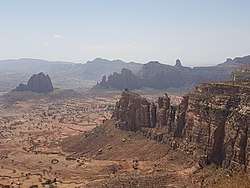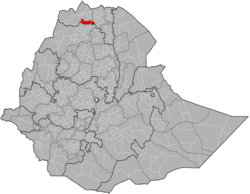Tselemti
Tselemti (Tigrinya: ፀለምቲ) is one of the woredas in the Tigray Region of Ethiopia.[1] Part of the Semien Mi'irabawi (North Western) Zone, Tselemti is bordered on the south by the Amhara Region, on the west by the Mi'irabawi Zone, on the north by Asigede Tsimbela, on the northeast by Medebay Zana, and on the east by the Mehakelegnaw (Central Area) Zone. The Tekezé defines the boundary between Tselemti and both the last two woredas and the Zone; other rivers in this woreda include the Abata, a tributary of the Tekezé. The administrative center of this woreda is Mai Tsebri; other towns in Tselemti include Dima.
Tahtay Koraro | |
|---|---|
 | |
 Flag | |
 | |
| Region | Tigray |
| Zone | Semien Mi'irabawi Zone (North Western) |
| Area | |
| • Total | 3,858.66 km2 (1,489.84 sq mi) |
| Population (2007) | |
| • Total | 138,858 |
History
Tselemti historically has always been part of the old Tigray state (and before that, it was part of Kingdom of Axum where its capital city was Axum).[2] However, at the mid of Haile Selassie's rule of Ethiopia (in 1941 & in 1943), Tselemti, Welkait, Tsegede, Raya and some other provinces were taken away from the old Tigray state and they were given to Begemder and to Welo provinces. One of the reasons why Raya was given to Welo was because Haile Selassie's son Crown Prince Amha Selassie was appointed as the governor of Welo. According to historical books, Tigray state's south-eastern border has always been Alewha river (i.e. Tigrinya: አሉሃ ምላሽ), which used to include Kobo district.
Tselemti, Welkait, Tsegede and some other provinces were given to Begemder since there was armed rebellion in Tigray against Haile Selassie's rule, so it was part of the effort to divide and rule Tigrayans. Therefore, from 1943 until the 1995 constitution ratification, Tselemti was part of Begemder province. Tselemti was then split into two parts once ethnic federalism was established in Ethiopia (in 1995). One of the two parts which now turned up to have a majority Amhara ethnic people living in it, was given to the new Amhara Region (this province is called Addi Arkay woreda, which is a Tigrinya language name). The other, still had a majority of Tigrayan ethnic people (over 90% Tigrayan ethnic people) so it was returned to the Tigray Region, as it had been for most of the 3000 years history of Ethiopia,[3][4][5] before Haile Selassie changed it in 1941/1943.[6][7][8]
The decline of the Tigrayan population in Ethiopia during Haile Selassie's reign – in particular in districts of the former Tigray province, which are given to the present-day Amhara Region, like Addi Arkay (woreda), Kobo (woreda) & Sanja (woreda) – is likely to have been as a result of Haile Selassie's suppression and systematic persecution against non-Amhara ethnic peoples of Ethiopia (in particular, his immense systematic persecution of Tigrayans). For example, on the 1958 famine of Tigray, Haile Selassie refused to send any significant basic emergency food aid to Tigray province despite having the resources to; as a consequence, over 100,000 people died of the famine (in Tigray province).[9][10][11]
Later on, the Mengistu Haile Mariam-led brutal military dictatorship (Derg) also used the 1983–1985 famine in Ethiopia as government policy (by restricting food supplies) for counter-insurgency strategy (against Tigray People's Liberation Front guerrilla-soldiers), and for "social transformation" in non-insurgent areas (against people of Tigray province, Welo province and such).[12][13][14] Due to organized government policies that deliberately multiplied the effects of the famine, around 1.2 million people died in Ethiopia from this famine where majority of the death tolls were from Tigray province (and other parts of northern Ethiopia).[15][16][17]
Demographics
Based on the 2007 national census conducted by the Central Statistical Agency of Ethiopia (CSA), this woreda has a total population of 138,858, an increase of 97,630 over the 1994 census, of whom 70,108 are men and 68,750 women; 8,623 or 6.21% are urban inhabitants. With an area of 3,858.66 square kilometers, Tselemti has a population density of 35.99 people per square kilometer, which is less than the Zone average of 40.21. A total of 30,485 households were counted in this woreda, resulting in an average of 4.55 persons to a household, and 29,805 housing units. The majority of the inhabitants said they practiced Ethiopian Orthodox Christianity, with 98.47% reporting that as their religion, while 1.51% of the population were Muslim.[18]
The 1994 national census reported a total population for this woreda of 97,630, of whom 49,893 were men and 47,737 were women; 5,301 or 5.43% of its population were urban dwellers. The two largest ethnic groups reported in Tselemti were the Tigrayan (89.12%), and the Amhara (10.63%); all other ethnic groups made up 0.25% of the population. Tigrinya is spoken as a first language by 87.18%, and 12.73% speak Amharic; the remaining 0.09% spoke all other primary languages reported. 97.98% of the population said they were Ethiopian Orthodox Christianity, and 1.77% were Muslim. Concerning education, 5.13% of the population were considered literate, which is less than the Zone average of 9.01%; 5.91% of children aged 7–12 were in primary school, which is less than the Zone average of 11.34%; 0.34% of the children aged 13–14 were in junior secondary school, which is also less than the Zone average of 0.65%; and 0.06% of children aged 15–18 were in senior secondary school, which is less than the Zone average of 0.51%. Concerning sanitary conditions, 0.77% of the urban houses and about 5% of all houses had access to safe drinking water at the time of the census; 9.07% of the urban and about 2% of all houses had toilet facilities.[19]
Agriculture
A sample enumeration performed by the CSA in 2001 interviewed 28,435 farmers in this woreda, who held an average of 1.31 hectares of land. Of the 37,127 hectares of private land surveyed, over 85.59% was in cultivation, 3.03% pasture, 3.86% fallow, 0.18% in woodland, and 7.3% was devoted to other uses. For the land under cultivation in this woreda, 79.16% was planted in cereals, 1.82% in pulses, and 4.24% in oilseeds; the area in vegetables is missing. The area planted in fruit trees and gesho is missing. 88.76% of the farmers both raised crops and livestock, while 7.45% only grew crops and 3.8% only raised livestock. Land tenure in this woreda is distributed amongst 88.49% owning their land, and 11.49% renting; none were reported as holding their land under other forms of tenure.[20]
Notes
- C.F. Beckingham and G.W.B. Huntingford, Some records of Ethiopia, 1593-1646 (London: Hakluyt Society, 1954), p. 243. The earliest surviving mention of this area is in the Futuh al-Habasha, written shortly after 1559. (Sihab ad-Din Ahmad bin 'Abd al-Qader, Futuh al-Habasa: The conquest of Ethiopia, translated by Paul Lester Stenhouse with annotations by Richard Pankhurst [Hollywood: Tsehai, 2003], p. 84). Huntingford, George Wynn Brereton. The Historical Geography of Ethiopia: From the First Century Ad to 1704. Oxford: Oxford University Press, 1989.
- "The British Museum, "The wealth of Africa:- The kingdom of Aksum"" (PDF).
- "Bernard Leeman, THE REALM OF D'MT - ONE AND THE SAME AS QUEEN YODIT'S DAMOT?".
- Shaw, Thurstan (1995), The Archaeology of Africa: Food, Metals and Towns, Routledge, p. 612, ISBN 978-0-415-11585-8
- "The British Museum, "The wealth of Africa:- The kingdom of Aksum"" (PDF).
- Bereket Habte Selassie, "Constitutional Development in Ethiopia", Journal of African Law, 10 (1966), p. 79.
- "Sarah Vaughan, "Ethnicity and Power in Ethiopia", PhD dissertation, p. 123, 2003" (PDF).
- The 1994 Population and Housing Census of Ethiopia Results for Tigray Region. 1. Addis Ababa: Central Statistical Authority. 1995. p. 70.
- "Bahru Zewde, [London: James Currey, 1991], p. 196. "A History of Modern Ethiopia: 1855–1974"".
- "Peter Gill, p.26 & p.27. "Famine and Foreigners: Ethiopia Since Live Aid"" (PDF).
- "Mesfin Wolde Mariam, "Rural Vulnerability to Famine in Ethiopia: 1958-77"".
- de Waal 1991, p. 4–6.
- Young 2006, p. 132.
- "Peter Gill, page.43 "Famine and Foreigners: Ethiopia Since Live Aid"" (PDF).
- "Peter Gill, page.44 "Famine and Foreigners: Ethiopia Since Live Aid"" (PDF).
- "Dawit Wolde Giorgis, "Red Tears: War, Famine, and Revolution in Ethiopia"".
- de Waal 1991, p. 5.
- Census 2007 Tables: Tigray Region, Tables 2.1, 2.4, 2.5 and 3.4.
- 1994 Population and Housing Census of Ethiopia: Results for Southern Nations, Nationalities and Peoples' Region, Vol. 1, part 1, Tables 2.1, 2.12, 2.19, 3.5, 3.7, 6.3, 6.11, 6.13 (accessed 30 December 2008)
- "Central Statistical Authority of Ethiopia. Agricultural Sample Survey (AgSE2001). Report on Area and Production - Tigray Region. Version 1.1 - December 2007" Archived 2009-11-14 at the Wayback Machine (accessed 26 January 2009)